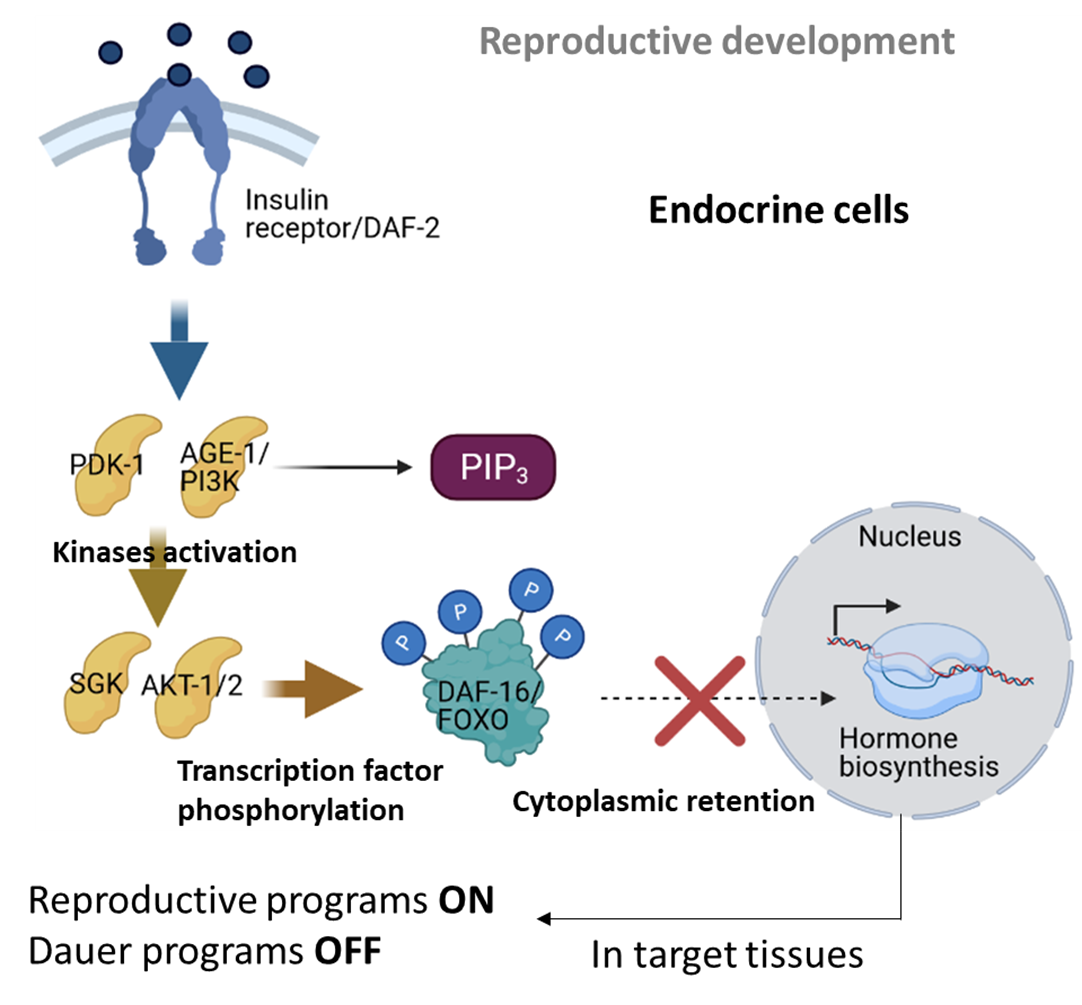C. Elegans and its adaptations
1/39
There's no tags or description
Looks like no tags are added yet.
Name | Mastery | Learn | Test | Matching | Spaced |
|---|
No study sessions yet.
40 Terms
c. elegans
invertebrate
roundworm - not an earthworm
belongs to the phylum nematoda and the taxonomic group ecydosozoa
have non segmented bodies
found nearly everywhere: fruit, water, soil, animals, plants
most abundant animal on earth
discovery
N2 bristol strain is the wildtype strain
Hawaiian strains are social worms and cluster together on the plate
horwitz and sulston mapped how cells mature into tissues and organs
culture
free living - can be grown on an agar plate
feed on E.coli OP50
maintained at 20 degrees
NGM plates (nematode growth media)
can be frozen up to -80 for stock miantenace
strains can be acquired in post
sexual forms
HEMAPHORODITE
XX
can produce sperm and oocytes which it can fertilise and lay
all genetically identical - useful progeny
MALE
cant produce their own eggs
useful for gene knockouts
has rays which contain sensory neurons
uses the fan to locate the position of the vulva so it can fertilise
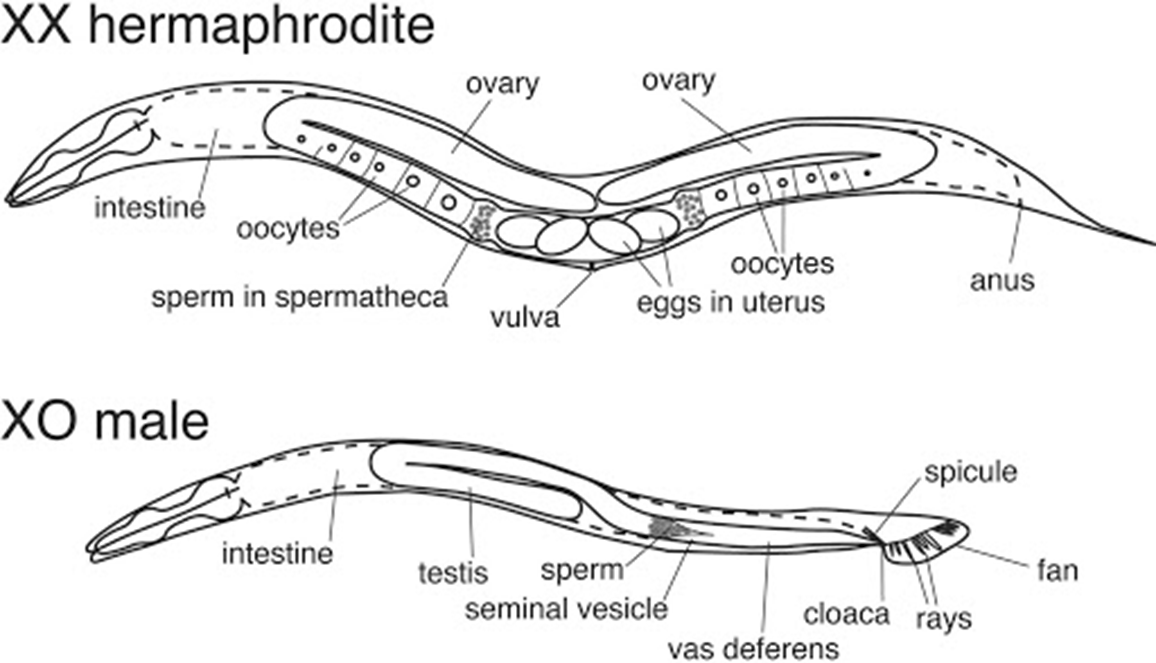
anatomy
pharynx: muscular structure innervated by 20 neurons which is important for sucking up bacteria
reproductive tissue like conveyer belt which is geared up to propogate and produce progeny (300-350)
cylindrical body shape
dark cuticle around the outside which is selectively pereable
keeps things out
hydrostatic pressure
below the cuticle is hyperdermis and body wall muscle cells
within the muscular structure is the gut and the intestines which are bathed in fluid
this fluid is the closest thing to blood and is used for long distance signalling
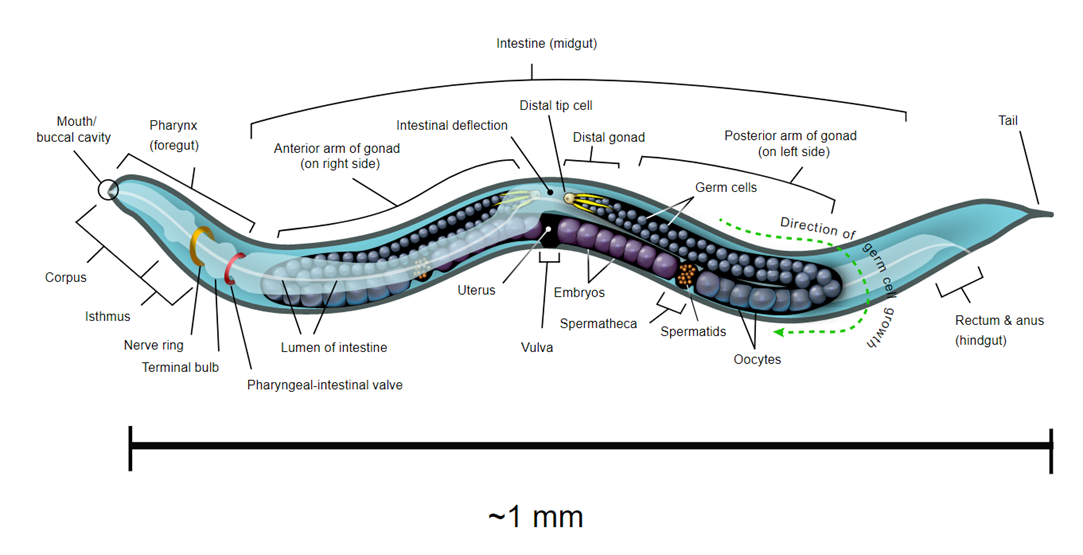
muscle types
phalangeal muscle - main one for feeding
body wall muscle
head and neck muscle
vulval muscle: main one for reproduction
intestinal muscle
anal muscle
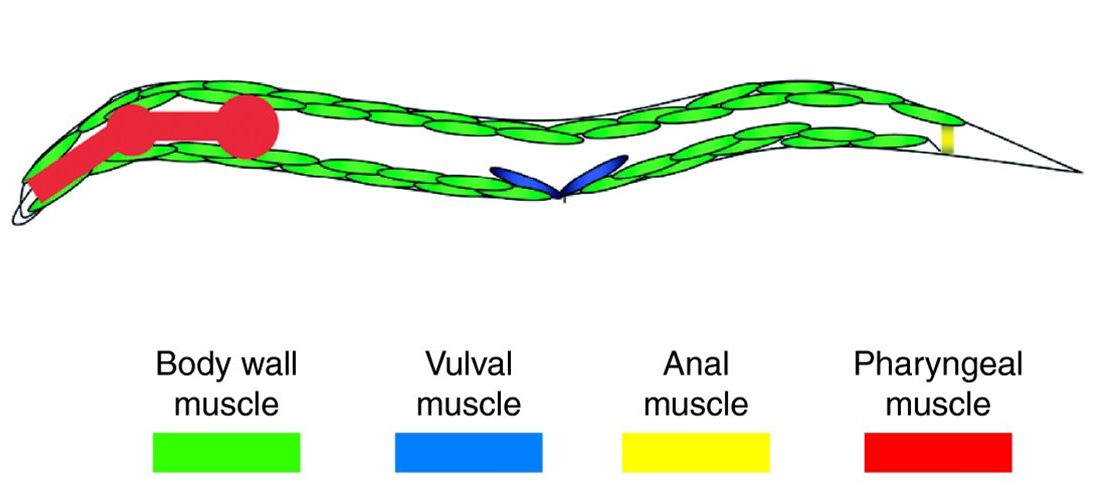
nervous system
302 neurons in hemaphorodites
nerve rings and nerve chords
lots of interneurons in the nerve ring
ventral and dorsal nerve chords which are interneurons
can be broken down into somatic (282) and pharangeal neurons (20) with one neuron linking the two
have motor neurons, sensory and interneurons
know the connectome: anatomical connection for all the neurons
labelled by dorsal, ventral left or right
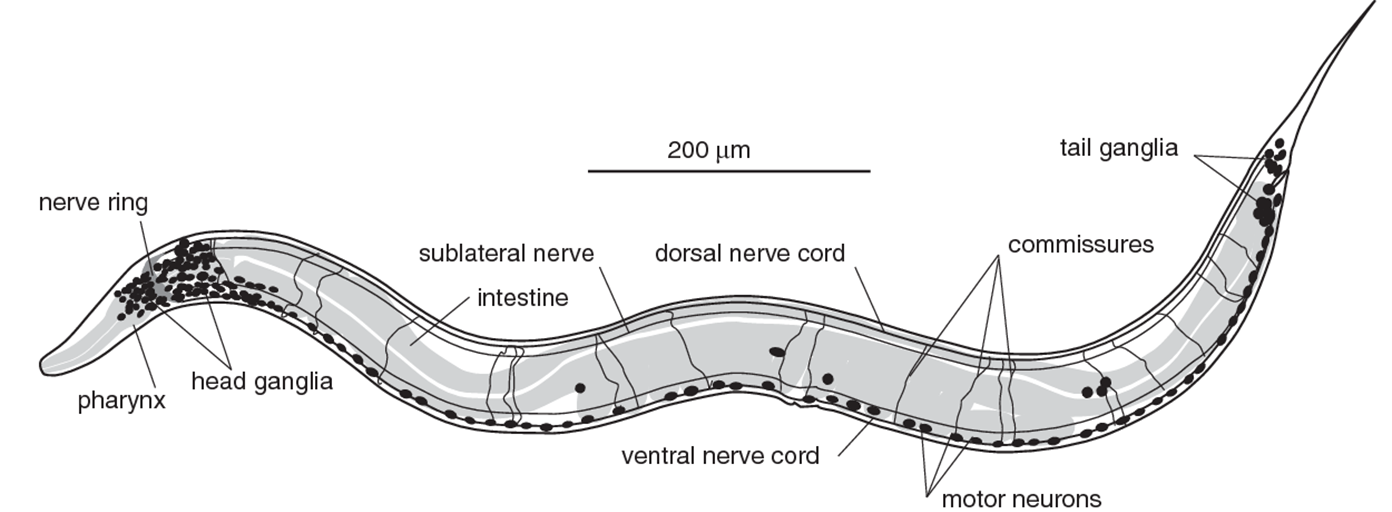
sensory neurons
12 amphid neurons in the head which are bilaterally paired —> detect external cues
ciliarry endings which extend to the nose and are externally exposed
neurotransmitters
similar nervous system to us with a few differences
2 that we dont have: tyramine and octopamine (acts as NAdr)
conservation across nt synthesis ( packed in vesicles and taken up)
conserved enzymes which break down nts
neuropeptide that modulates synapses
genetics
first multicellular organism to have genome sequenced
100MB genome
5 pairs of chromosomes
we can do genetic screening and gene knockouts
GENETIC SCREENING: expose worm to mutant and allow it to lay eggs —> look for phenotype that is different and examine genome to see what has changed
REVERSE GENETIC SCREEN: have a gene of interest —> mutate the gene and insert it into worm to see how it impacts the worm
MICROINJECTION: transform worms to express certain proteins
pharynx and feeding
predominatly hemaphorodites used
two roles of the pharynx: peristalsis and pumping
pharynx found in transparent region (can be used to measure activity)
darker region is the intestine
draws bacteria into the pharynx to the intestine
pharynx is a muscular structure controlled by the NS
MECHANISM FOR FEEDING
sequential relaxation and contraction is required to suck in bacteria through bucal opening
when the muscle is contracted the lumen opens
spits out the fluid the bacteria is in to condense it down
the muscle is relaxed and the lumen shrinks to spit out fluid
peristalsis moves pellet through the corpus (made up of the procorpus and the metacorpus) , through the isthmus which connects the corpus to the grinder
ground down by grinder in terminal bulb
contraction and relaxation of muscle controlled by gap junctions
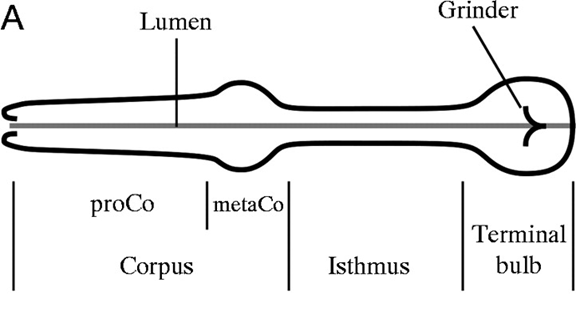
albertson and thompson
characterised structures of teh NS
20 neurons NS
characterised by motor neurons, interneurons and dual function neurons
sometimes neurons ahve to do more than one job
muscle anatomy
surround the lumen of the pharynx
8 diff muscle cell types
PM - pharangeal muscle
triradial symmetry - around 3 axes of symmetry
radially orientated muscles in corpus and terminal bulb needed for opening and closing of lumen by relaxing and contracting
longitudinal muscles move bacteria aling the lumen of the isthus
linked by electrical synapse —> NOTE: some muscles controlled by chemical and electrical synapse, but all motor neurons controlled by chemical synapse)
sieve structures which allow the worm to keep the bacteria and remove the liquid
terminal bulb is a rigid structure which is the extension of external cuticle which opens and closes in the grinder (contraction of the muscle causes opening of the lumen)
laser ablation
laser ablation allows you to remove any neuron in the nervous system and observe what happens:
M4 neurone
coordinates peristalsis
is we laser ablate the pharynx becomes stuffed, unable to move bacteria into the gut
doesnt develop into adulthood
M3 also has a role in rate of pumping
MC
laser ablation leads to a slower feeding rate
coordinates feeding rate
is a cholinergic neuron
genetic ablation
can do gene knockouts and observe what happens
release of neurotransmitters requires primary docking and release of vesicle —> unc13 protein is important for this
UNC13
sits within the vesicle docking complex
gene knockout impacts behaviour of the worm
disrupted release of vesicles which impacts NS and rate of pumping
unc13 mutant has slower rate of feeding
can still pump with disrupted NS
pharangeal NS
required for modulating the activity of the pharynx
as its transparent we can use GFP reporter to tell us which cells express which genes
Eat 4 is a glutamate transporter which loads up vesicles with glutamate
allows us to assign nts identity to neurons
donw via engineered plasmids which can be injected into worms reproductive system
can start to map out NS with their nts
either serotonin, glutamate, cholinergic
link between extrapharangeal NS and pharangeal NS (can still pump if its disrupted)
has the ability to respond to neurohormonal signalling (signals that act on tissue from outside the tissue and can do long distance signalling)
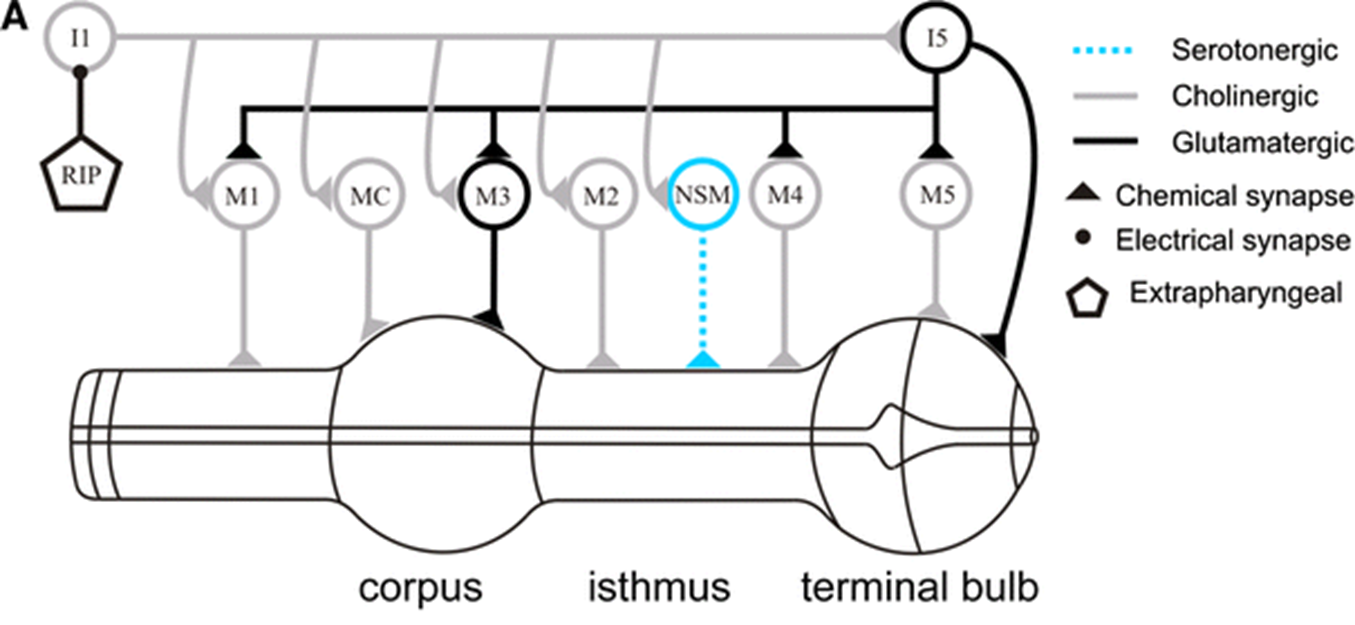
quantifying NS activity
can make counts of activty of the grinder - gives a readout for how fast the worm is feeding
measured in pumps/min (1 grinder movement i open - close - open)
done on age synchronised worms)
amphids are exposed to external environment - amphids feed into sensory neurone (ADF) which releases serotonin to MC (motor neurone important for determining feeding rate)
MC is a cholinergic neuron (receives serotonin through ser 7 5HT receptor which is a Gas GPCR)
MC neurons cause increase feeding arte when signalled to with serotonin
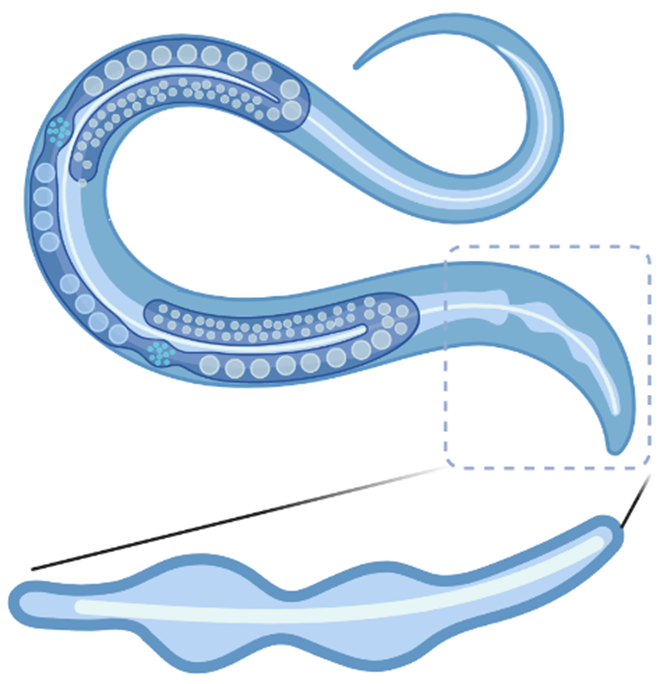
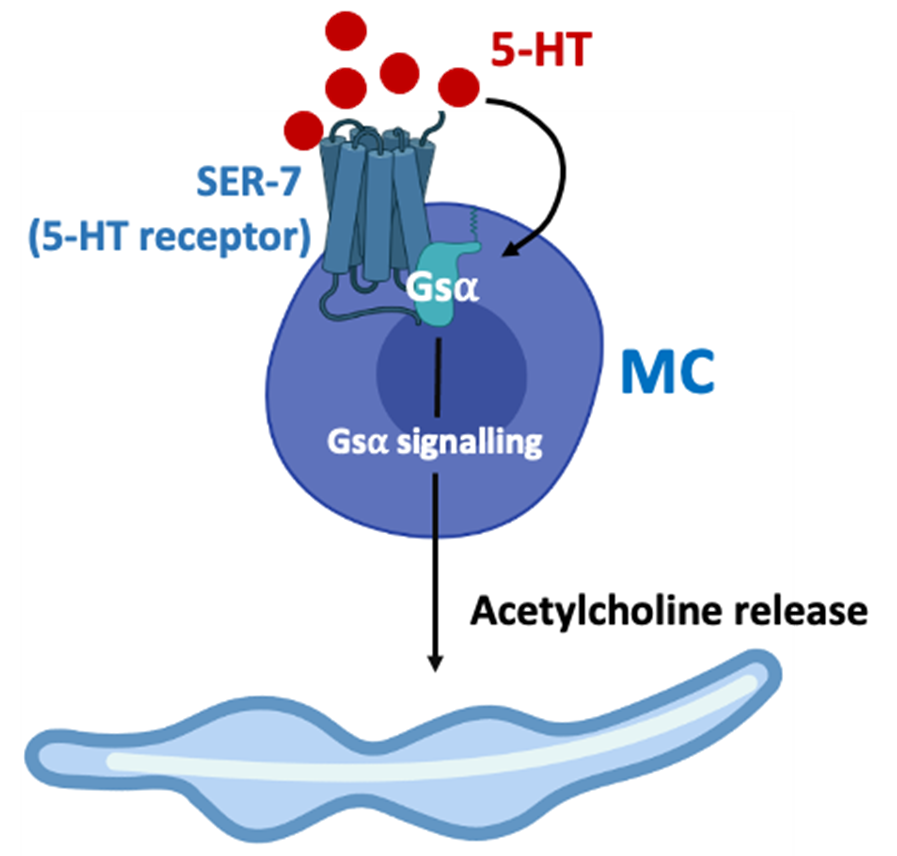
mechanism
mutant without tph1 mutant cant biosynthesise 5HT —> the worm no longer pumps at high rate in food prescence
nicotinic receptor eat 2 responds to the Ach, when Eat 2 is ablated feeding behaviour is disrupted
this pathway is important for high rate of feeding on food
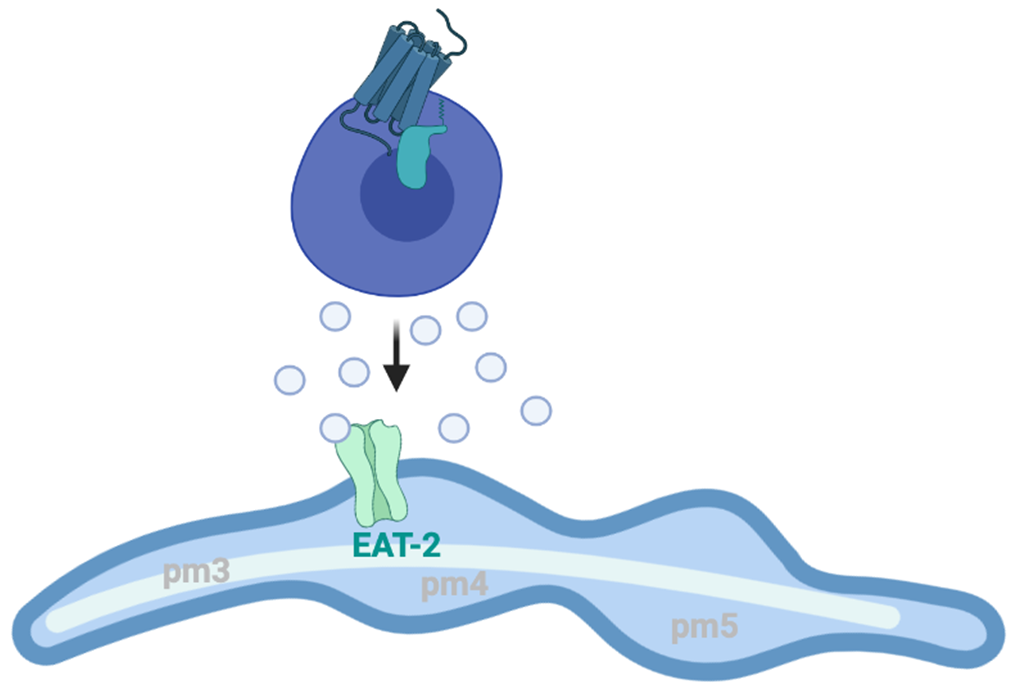
off food
turns down feeding activity
M3 motor neuron sends an inhibitory signal to supress the pharangeal pumping
signals through choinergic glutamate gated ion channel
can remove EAT 4 from M3 (vesicle loader) and causes high rate of pumping
Eat 4 is important for loading glutamate which is responsible for supressing pumping
egg laying physiology
HSN neuron connects pharynx to vulva and coordinates egg laying
needs to adapt where it lays progeny into environment where it will best survive
anatomy of C, elegans reproductive system
2 U shaped gonad arms (branches of the reproductive system that converge onto the vulva and uterus) - one in posterior and one in anterior
2 so that if one is damaged it can still lay eggs
DTC continually produces mitotic cells which undergo meiosis
like a production line, cells produced, cells mature, cells fertilised, move into the uterus (oocytes —> embryos (when fertilised) —> eggs)
can produce around 300 progeny on its own
uterine and vulval muscles, 2 types of each
uterine muscles like an elastic band round the uterus and helps squeexe out eggs
vulval muscle cells involved in opening and closing of vulva
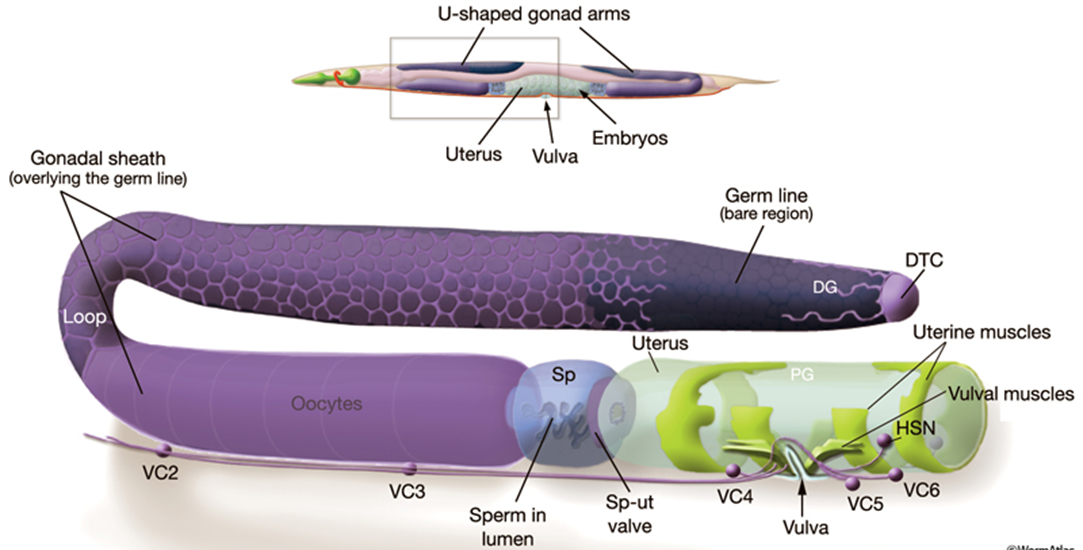
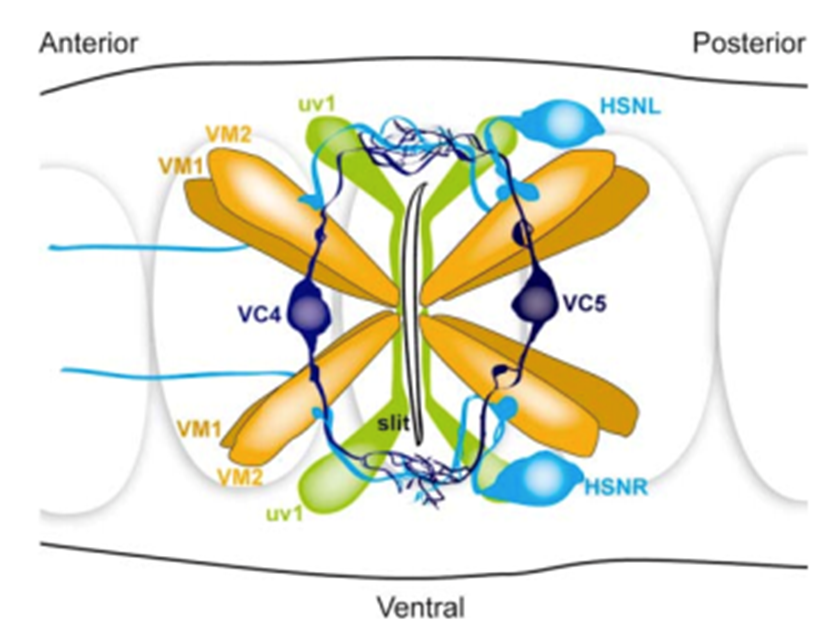
HSN neuron
HSNL and HSNR act as a bilateral pair
control egg laying physiology
laser ablation of HSN neurons impact egg laying behaviour
male worm doesnt have HSN neuron - are deleted as they develop
HSN neurons express arrestin which can be tagged with GFP to determine where neurons go
HSN express tph1 (tryptophan hydroxylase) which causes tryptophan to be converted to 5HT and these neurons also secrete 5HT
laser ablation of HSN
if the left is removed it can still lay eggs, same if right removed
only if both are ablated is egg laying affected
egg laying
connected circuit between neurons and muscles
HSN speaks to VC neurone but also some muscle cells (via chemical synapse)
also electrical synpased between muscles to allow co-ordinated movement
each of the groups of muscle cells have different roles
eggs lay in certain patterns (bursts)
bursts are intersperced with inactive phases
response to sensory cues
can change the rate of egg laying in reponse to: salt conc. impact of food
in absence of bacteria: retain eggs
straved of food: eggs retained but develop into larvae which will eat the adult worm from the inside out (bag of worms)
pharmacological experiment
serotonin released into synapse and induces signalling, then reuptaken
use drugs such as impipramine whih inhibits reuptake —> increased electrical activity of postsynaptic cells
when exposed to serotonin increased egg laying rate, same as when imipramine is used ( this is because serotonin is used at the synpase and imipramine blocks reuptake)
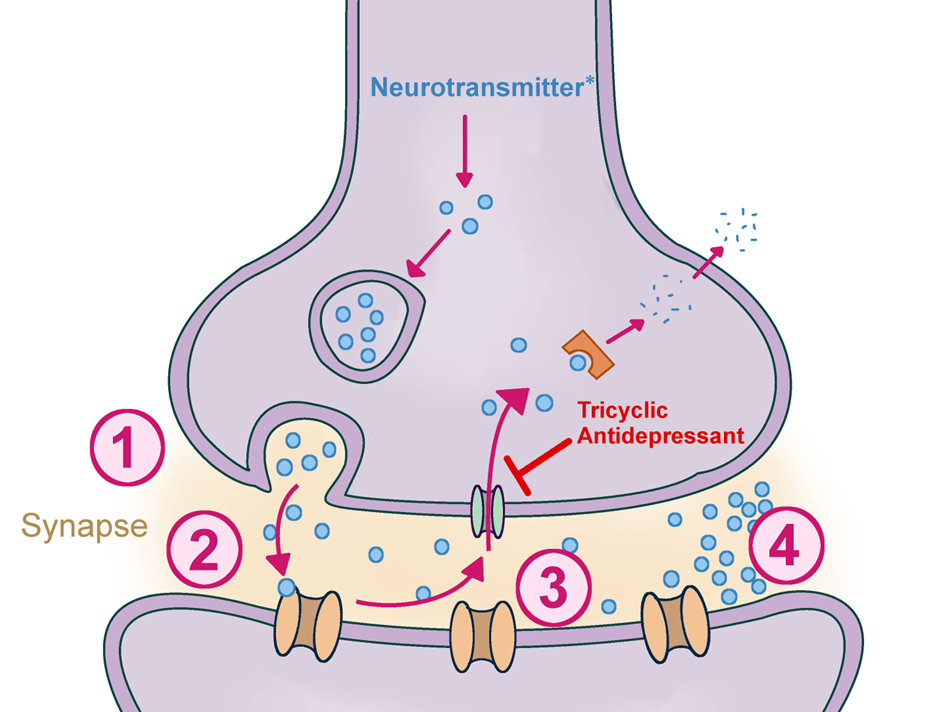
inactive and active states
genetic knockout of serotonin signalling and laser ablation have the same effect
active phase is the same but much longer inactive period
hypothesised that serotonin is required for the switch between active and inactive states
burst in active phase is driven by Ach
neuropeptides
class of signalling molecules
neuromodulators which turn up/down signalling at synapses
can cause slower neuromodulatory signalling
signal through GPCRs
can conduct neurohormonal signalling too
4-20AAs which are derived from larger precursors
3 families of neuropeptides:
insulin related peptides
non insulin related and non FMRFamide
FMRFamide
genetic screening
form mutants and search for mutant phenotype
can then map the mutated phenotype
in mutants where egg laying was defective mutated genes were egl3 and egl21
these code for enzymes which cleave the precursor
mutants which dont produce flp neuropeptide still lay eggs and egg laying is still clustered into active and inactive phases but inactive phase is lomger
flp and serotonin are both important for egg laying
as serotonin concentration increases so does rate of egg laying but this is not observed with flp1 —> flp1 needed to enhance egg laying by serotonin
flp1 expressed in some of the amphineurons that detect food so may be involved in food dependentt responses
egg laying rate decreases with removal of food
flp1 mutants have low egg laying rate on food and dont adapt to off food therefore flp1 important in adaptive behaviour
AIA and AIY neurons in nose express flp1 which signals to HSN which controls vulval muscle cells to adapt physiology
role of EGL4
identified from a screen
mutants have lower rate of egg laying and dont adapt when theres no food around
also have reduced egg laying rate in response to serotonin
Egl4 required for the mediating induction of active state by serotonin
Egl4 is a serine threonine kinase also called protein kinase G
role in neural plasticity and regulation of gene transcription
Egl4 translocated to the nucleus and adapts response of sensory neuron to odours
has 2 domains: one binds cGMP, the other acts as a kinase
expressed in neurons required to detect food cues (heavily expressed in sensory and interneurons)
development of C. elegans
eggs remain in adult for 150 mins
3 days from egg to adult at 20 degrees
period of cell division, followed by period of elongation and metamorphosis
muscles activated so worm starts to move around within the egg (quickening phase)
then bursts out of egg shell (shell provides a barrier for the worm as it develops)
after the worm hatches it progresses L1-L4 where theres 4 larval stages
development can take diff amounts of time depending on temp
outer cuticle is shed (acts to protect worm)
dauer is an alternative state that the worm can enter depending on the environment
L4 stage is characterised by the appearance of a vulva
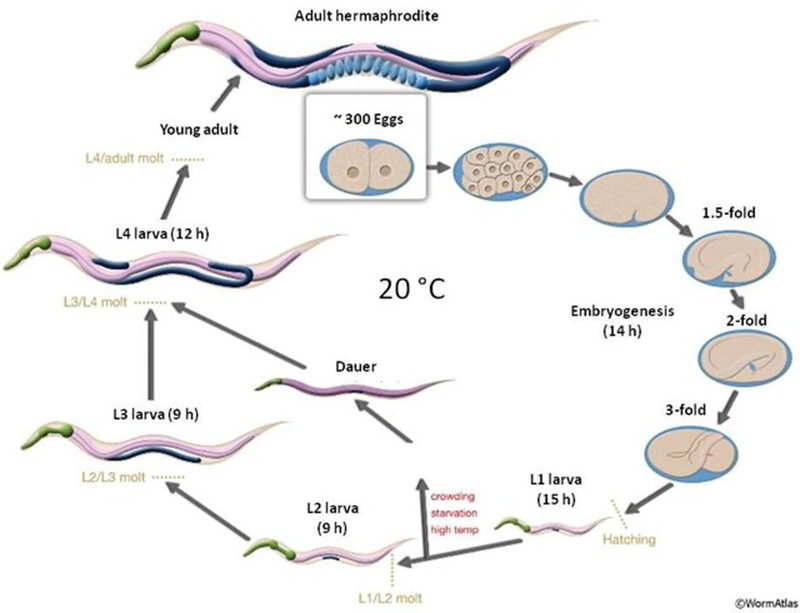
L1 arrest
if theres a lack of food L1 remains as L1
can survive up to 2-3 weeks with no food
post embryonic development not initiated
if food is present development continues
late L4 development
if the worm is starved at late L4 they will still molt into adults ut enter an adult reproductive dispause (stop producing embryos)
prolonged starvation can lead to shrinkage of the germ line, progranmmed cell death —> reduction of germ cells
distal tip cells shut down to reduce no of germ line cells passing through
if exposed to food, ability of reproductive tissues to develop and lay eggs restored
dauer
if its L1 and encounters factors below will malt and become dauer
crowding
starvation
high temp
worms can survive many months and can exit when conditions improve —> doesnt ipact on lifespan/dvelopment out of dauer state
dauer state is good at survival
incubated with SDS detergent which cuases denaturation of proteins (worms incubated in this really good at survival and can resist harsh chemicals)
dauer state considered state of quiescence
quiescnec defined as: dormant state in which metabolism is slowed down in response to stress
dormant state ended when period of stress is relieved and worms can return to their normal activity
also seen in lots of other types of nematode
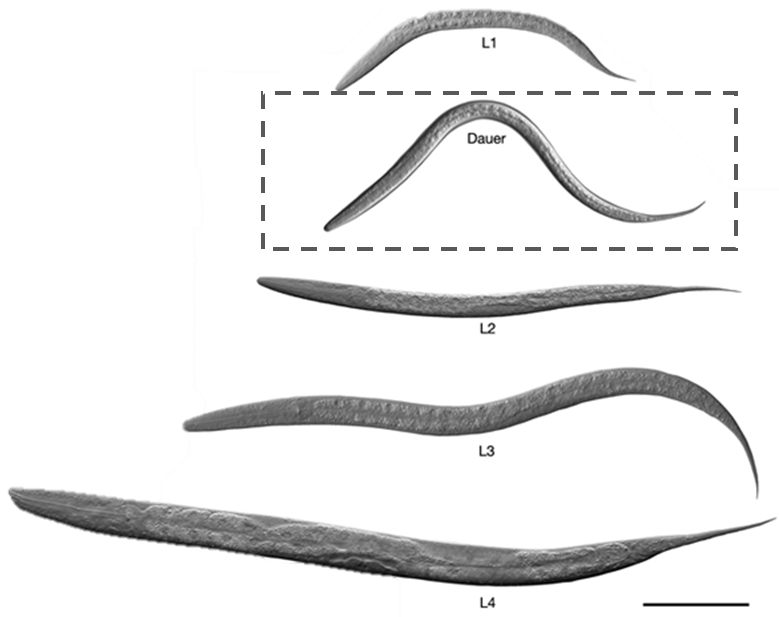
environmental cues
food, temp, pheramones - sensed by sensory neurons and integrated to produce behaviour)
the maount of pheramones a worm detects gives a readout of how many worms are in surrounding environment
once a worm has developed into a normal L2 it will keep developing into L4
dauer adjusts the metabolism and morphology
c. elegans in the wild
have a boom and bust lifesyle
find food, lays eggs, increased population which results in less food
ferociuos feeders, not conservative and sop when food is low eneters the dauer state which initiates behaviours to where it will hunt and attempt to find food
L2 dauer finds new food rich environment which is beneficial for survival and proliferation
the new environment must have:
low population
bacteria rich
morphological/metabolic change
thinner
arrests germ line development
shrinkage of muscle, intestine, hyperdermal cells
encapsulation of worms nose from cuticle
also closes off the other end of the gut
thicker cuticle
more protective
prevents fluid leaving
helps the worm locomote
pharynx constricted and doesnt pup to conserve energy
faster
physiology of quiescent stage
NORMAL STATE
bacteria taken in and nutrients distributed to muscle
uses TCA cycle to generate ATP
ATP used for growth, development, movement
DAUER
metabolism slowed down
increased lipid stoage, conversion of glycogen which is distributed to muscle cells
no anaerobic metabolism
reliant on energy stores
signalling pathways
DAF = dauer forming genes
genes involves in pheramone production, cillium structure
diff genes form cilia for detection of sensory cues
DATD drives the formation into dauers
DATC are constituatively expressed
DAF 2
expressed ubiquitously throughout
this is good as allows for coordination of tissues
DAF2 gene encodes an insulin receptor which recieves insulin from a sensory neurone —> allows to signal to other cells
DAF2 is a tyrosine kinase receptor
number of components in insulin pathway preserved in mammalian signalling pathway
insulin (when food is around) activates DAF2 —> activates kinase signalling cascade which activates foxo TF
foxo cant translocate into nucleus which drives reproduction
so when insulin is low foxo can move to nucleus and inhibit hormone biosynthesis
when insulin is high foxo activates and cant enter nucleus so hormones synthesised as usual
